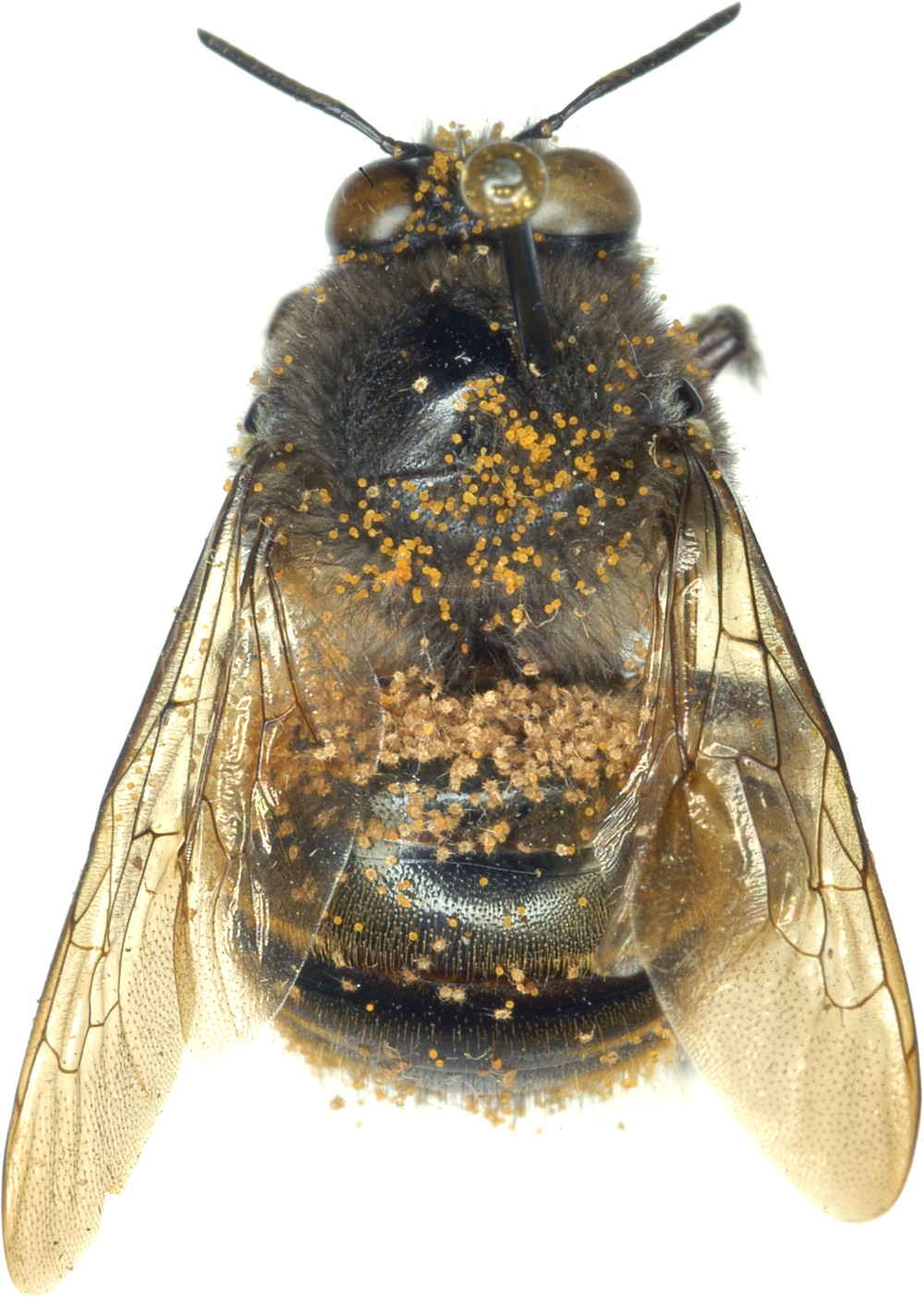Bee Mites : Acari : Acariformes : Sarcoptiformes : Chaetodactylidae : Sennertia : Sennertia species
Sennertia hurdi Klimov and OConnor, 2008
Sennertia hurdi Klimov & OConnor, 2008: 164, Figs 82-83.
Material (show database records). Holotype: HDN - MEXICO: Oaxaca Presa Benito Juárez, nr. Jalapa de Marquez, hwy 190, 6:10-6:16 am, 8 Sep 1968, D. H. Janzen Passiflora, ex Xylocopa tabaniformis tabaniformis (on propodeum), LACM 208290 BMOC 04-1122-021. Paratypes: 12 HDNs - same data as holotype; 18 HDNs - same data, LACM 208289 BMOC 04-1122-020; 37 HDNs - Temascal, 27 Sep 1963, D. H. Janzen, Cucurbita pepo (Violales: Cucurbitaceae), ex X. t. azteca (on 1st metasomal tergite), LACM 208285 BMOC 04-1122-023; 17 HDNs - 2 mi N "La Tinaja", 6:30 am, 21 Oct 1963, No collector, ex Xylocopa tabaniformis azteca (on propodeum), LACM 208284 BMOC 04-1122-022. Holotype in LACM, paratypes in LACM, UMMZ, UNAM.
Description. Phoretic deutonymph . Gnathosomal solenidia shorter than 1/3 of femur I width. Supracoxal setae scx situated on separate small sclerite. Hysterosomal shield lateral gland openings and bases of f2 nearly on edge of hysterosomal shield, or the former outside the shield. Lateral edges of hysterosomal shield in anterior part not narrowing. Dorsal hysterosomal pouch absent. Distance between anterior margin of hysterosomal shield and setae si exceeds diameter of si bases. Striate pattern of idiosomal cuticle outside hysterosomal shield without sclerotization, formed by long striae. Distinct rudiments of vi present. Setae si distinctly posterior se, exceed 1/2 of se, almost as thick as se. Diameter of si exceeds 1/2 of diameter of se. Setae c1 almost 2 times longer than d1; distinctly longer than h1; c1 long, nearly as long as se; situated anterior to hysterosomal shield. Setae d1 and e1 distinctly longer than h1; situated on hysterosomal shield. Sclerite between ia and d2 absent. Setae e2 subequal with d2; not touching hysterosomal shield. Setae h3 shorter than 110. Lateral gland openings situated outside hysterosomal shield, with usual distinct transverse slit. Setae 4b, g, and 4a without distinct rhomb-like widening, filiform. Setae 4b, pR I-II, sR III, wF IV, gT I-II, hT I-II, kT III, ra I-II, and wa I-II filiform. Setae 4a not reaching transverse level of pores ip. Posterior apodemes II and anterior apodemes III free. Posterior processes of coxal apodemes IV not reaching level of anterior cuticular suckers rudiments. Anterior apodemes IV not interrupted, almost straight. Posterior apodeme IV absent. Conoids ps2 posterior to anterior transverse level of central suckers (ad1+2); anterior to ps1, situated outside outer level of ad1+2. Transparent margin of anterior suckers (ad3) without rough sclerotization. Suckers ad3 not enlarged, smaller than central suckers. Posterior and lateral borders of attachment organ not forming distinct frame. Sclerotized rudiment of anterior cuticular suckers present. Longitudinal hysterosomal sclerite present, short. Ventral hysterosoma smooth. Genual setae mG I-II simple; mG II almost as long as leg II or longer. Tarsal setae la I-II longer than famulus ε. Tarsal setae ra I-II not bifid, blade-like. Tarsal setae wa I-II and s III filiform, needle-like, or widened basally but with attenuated end. Tarsal setae d I-II slightly widened. Tarsal setae d and f I-II almost symmetrical; d and f I not touching. Solenidion ω3 closer to f I than to ω1. Posterior condylophore present. Anterior condylophore I-II with distal bending. Seta d III situated close to tarsal base, distance usually subequal or shorter than diameter of d III alveolus. Leg IV protruding posterior edge of hysterosoma. Tarsus IV not enlarged, shorter or less than 2 times longer than width of trochanter IV. Setae w IV thinner than d IV and distinctly shorter than leg IV, situated on middle of tarsus IV. Setae s IV present. Seta wF IV almost reaching apex of tarsus or slightly protruding it.
Other instars unknown.
Hosts. Xylocopa (Notoxylocopa) tabaniformis tabaniformis; Xylocopa tabaniformis azteca.
Distribution (Show map). Mexico: Oaxaca.
Notes. Closely related to S. ignota, S. longipilis, and an undescribed species from X. funesta. The differences between them are given in the key to species.
Etymology. The new species in named after Paul D. Hurd, the renowned authority in systematics of Xylocopa.
References
Klimov, P. B. & B. M. OConnor. 2008. Morphology, evolution, and host associations of bee-associated mites of the family Chaetodactylidae (Acari: Astigmata), with a monographic revision of North American taxa. Miscellaneous Publications Museum of Zoology University of Michigan.199: 1-243.
B. OConnor and P. Klimov ©
Created: May 26, 2011
Last modified: 
